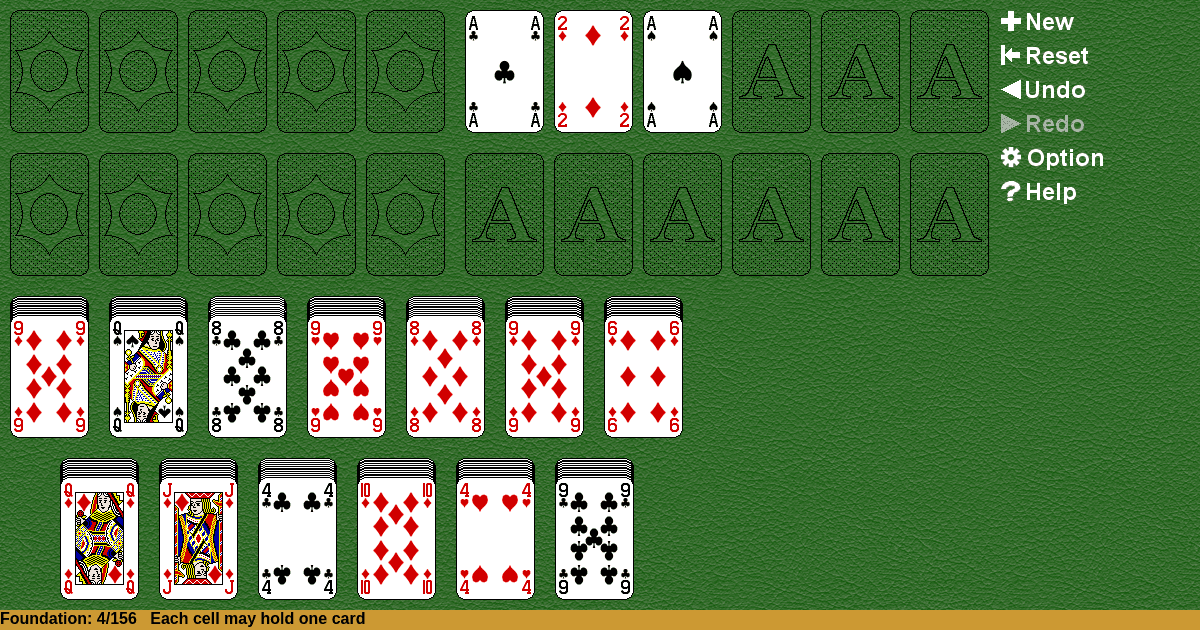Triple FreeCell
Home |
How to play |
FAQ |
About
How to play Triple FreeCell?
Game Objective:
The primary goal in Triple FreeCell Solitaire is to move all 156 cards (three standard decks) to the twelve foundation piles, building each foundation up in suit from Ace to King.
Setup & Layout:
- Deck: Triple FreeCell Solitaire uses three standard 52-card decks, totaling 156 cards.
- Tableau:
- Deal all 156 cards face-up into 13 tableau piles, with 12 cards in each pile.
- All cards in the tableau are dealt face-up; there are no face-down cards in this variant.
- Foundations:
- There are twelve foundation piles (one for each suit in each deck), which start empty.
- Cells:
- There are ten free cells (temporary storage spaces), all empty at the start. Each cell can hold only one card at a time.
- Play Areas Defined:
- Tableau: The main playing area with 13 piles where most card movement occurs.
- Foundations: The target area for winning, where cards are built up by suit.
- Cells: Auxiliary spaces for temporarily holding single cards.
Triple FreeCell Solitaire Rules:
- Card Movement Principles:
- Only the top card of each tableau pile or any card in a free cell may be moved at any time.
- Cards can be moved from the tableau or a cell to another tableau pile, to a free cell, or to a foundation pile.
- Building on Tableau:
- Cards are built down in rank and by alternating color (red on black or black on red).
- Sequences of cards in descending order and alternating color can be moved as a group, but only if there are enough empty cells to allow their movement (see Supermove rule below).
- Building on Foundations:
- Each foundation pile is built up in suit from Ace to King (e.g., Ace, 2, 3, … King), using cards of the same suit from any of the three decks.
- Free Cells:
- Each free cell can hold only one card at a time.
- Any top card from the tableau can be moved to an empty cell.
- Supermove Rule:
- Groups of cards in correct sequence (descending, alternating color) may be moved as a unit if there are enough empty cells to facilitate the move.
- The maximum number of cards that can be moved as a group is determined by the formula:
[ \text{Max cards} = (\text{Number of empty cells} + 1) \times 2^{\text{Number of empty tableau piles}} ] This allows for large group moves if many cells and tableau piles are empty.
Gameplay:
- Turn Sequence:
- On each turn, the player may move a card (or a valid sequence) from the tableau or a cell to another tableau pile, a free cell, or a foundation pile, following the movement rules above.
- Introducing New Cards:
- There is no stock or reserve; all cards are available from the initial deal. No new cards are introduced during play.
- When No Legal Moves Remain:
- If a player cannot make any more legal moves (no cards can be moved to tableau, cells, or foundations), play ends and the game is lost.
Winning & Losing Conditions:
- Winning:
- The game is won when all 156 cards have been moved to the twelve foundation piles, with each pile built up in suit from Ace to King.
- Losing/Unwinnable:
- The game is lost or unwinnable if no legal moves remain and not all cards are in the foundations.
- As with classic FreeCell, most deals are theoretically solvable, but poor planning can lead to unwinnable states.
Special Rules & Edge Cases:
- Filling Empty Tableau Piles:
- Any card or valid sequence (descending, alternating color) may be moved to an empty tableau pile, provided the move follows standard movement restrictions and the supermove rule.
- Filling Empty Cells:
- Any single card may be moved to an empty cell; cells cannot hold more than one card at a time.
- Multiple Decks:
- Since there are three decks, each suit appears three times. Each foundation pile must be built with cards of the same suit, in order from Ace to King, for each copy of the suit.
- No Stock or Redeal:
- There is no stock pile and no redeal; all cards are in play from the start.
- Sequence Movement Restriction:
- The number of cards that can be moved as a group is limited by the number of empty cells and tableau piles, as described in the supermove rule.
- No Card Removal from Foundations:
- Once a card is placed on a foundation pile, it cannot be moved back to the tableau or a cell.
Summary:
Triple FreeCell Solitaire is a multi-deck solitaire game that expands the classic FreeCell format to three decks, 13 tableau piles, 12 foundations, and 10 cells. The game is won by moving all cards to the foundations, following strict rules for movement, sequence building, and cell usage.

Solitaire Collection
About Triple FreeCell
Rate (Triple FreeCell)
4.7 / 5
1,916 votes



























































